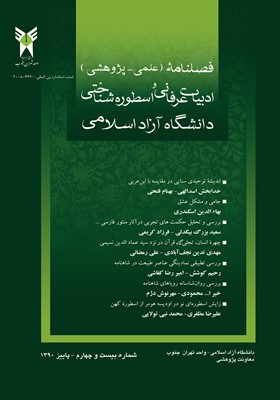زایش اسطورهای نو در اودیسة هومر از اسطورهای کهن
محورهای موضوعی : اسطورهعلیرضا مظفری 1 , محمدنبی تولایی 2
1 - دانشیار زبان و ادبیات فارسی دانشگاه ارومیه
2 - استادیار زبان و ادبیات فارسی دانشگاه آزاد اسلامی
واحد ارومیه
کلید واژه: آتنا, اولیس, هومر, اودیسه, هفائیستوس,
چکیده مقاله :
هومر در حماسة اودیسه به روایت ماجراهای قهرمان جنگ تروا یعنی اولیس و حکایت سرگشتگیهای او به هنگام بازگشت از آن نبرد به سوی زادگاهش، پرداخته است. در این روایت آنچه بیشتر نظر خواننده را به خود جلب میکند، حمایتهای بیدریغ آتنا از اولیس است. علت اساسی این همه حمایت آتنا از اولیس چیست؟ برای دستیابی به علل حمایتهای آن زن ایزد از اولیس، میتوان چندین احتمال را طرح کرد. در این گفتار نخست به علتیابی اسطورهشناختی و سپس به طرح علل فلسفی پرداختهایم. از منظر نخست، با همانندیهایی که میان آتنا و پنلوپ، همسر اولیس، و خود اولیس با هفائیستوس ایزد آتش زمینی حاکم است، میتوان چنین تصور کرد که آتنا با حمایت از اولیس نمودگار زمینی هفائیستوس میخواهد وفاداری و دلدادگی خود را به هفائیستوس برساند. از منظر دوم، با عنایت به اینکه آتنا برای مردم یونان، ایزد عقل و دانایی است و اولیس نیز همواره به خردمندی توصیف وستایش شده است؛ میتوان چنان پنداشت که حمایت آتنا از اولیس ، نمودِ روایی حمایت و تأیید عقل کل و آسمانی از عقل زمینی و جزوی بشری باشد.
The Odyssey, one of the major ancient Greek epic poems attributed to Homer, is mainly centereds on the Greek hero Odysseus, his wanderings and long journey home after the fall of Troy. In this journey, the goddess Athena constantly supports Odysseus. The main aim of the present article is to explain the reason of for this support. First of all, there are similarities between Athena and Penelope, the wife of Odysseus, and also, between Hephaestus, the god of fire, and Odysseus. It can be imagined that Athena, with protection of by protecting Odysseus, wants to show Hephaestus her love and fidelity. Second, for Greeks, Athena is the goddess of wisdom and on the other hand, Odysseus is symbol of reason. So, the support of Odysseus by Athena means that the Universal and Divine intellect protects the intellect that is partial and human.
کتابنامه
آیدنلو، سجاد. 1387. «جام فریدون» فصلنامة پاژ. س 1. ش 4.
اشمیت. ژوئل. 1387. فرهنگ اساطیر یونان و رم. ترجمة شهلا برادرانخسروشاهی. چ 2. تهران: فرهنگ معاصر- روزبهان.
الیاده. میرچا. 1365. مقدمه بر فلسفهای از تاریخ. ترجمة بهمن سرکارتی. چ 1. تبریز: نیما.
بلک. جرمی و گرین.آنتونی. 1383. فرهنگنامه خدایان، دیوان و نمادهای بینالنهرین باستان. ترجمة پیمان متین. چ 1. تهران: امیرکبیر.
پین سنت. جان. 1387. اساطیر یونان. ترجمة باجلان فرخی. چ 2. تهران: اساطیر.
ژیران، فلیکس. 1382. اساطیر یونان. ترجمة ابوالقاسم اسماعیلپور. چ1. تهران: کاروان .
سرکاراتی. بهمن. 1385. سایههای شکار شده. چ 2. تهران: طهوری.
شیخ محمود شبستری. 1381. گلشن راز. با تصحیح، پیشگفتار و توضیحات حسین الهی قمشهای. چ 4. تهران: علمی و فرهنگی.
صفا. ذبیح الله. 1366. تاریخ ادبیات در ایران. ج5. چ 3. تهران: فردوس.
گریمال. پیر. 1378. فرهنگ اساطیر یونان و رم. ترجمة احمد بهمنش. چ 4. تهران: امیرکبیر.
مظفری. علیرضا. 1385. «بررسی تطبیقی عناصر اساطیری روایت بیژن و منیژه». شاهنامهپژوهی. چ 1. زیر نظر محمدرضا راشد محصل.
هومر. 1371. اودیسه. ترجمة سعید نفیسی. چ9. تهران: علمی و فرهنگی.
ــــ . 1372. ایلیاد. ترجمة سعید نفیسی. چ 9. تهران: علمی و فرهنگی.
منابع انگلیسی
J.E .Cirlot. 1962 .A Dictionary of Symbols. Translated from the Spanish by Jack Sage. Foreword by Herbert Read. New york: Philosophical Library.
M.H .Abrams. 1987. (General Editor) The Norton Anthology of English literature. New York: Norton company, Inc.
Mircea Eliade. 1993. The Encyclopedia of Religion. Vol.5. New York: Macmillan Library Reference.
_||_منابع انگلیسی
J.E .Cirlot. 1962 .A Dictionary of Symbols. Translated from the Spanish by Jack Sage. Foreword by Herbert Read. New york: Philosophical Library.
M.H .Abrams. 1987. (General Editor) The Norton Anthology of English literature. New York: Norton company, Inc.
Mircea Eliade. 1993. The Encyclopedia of Religion. Vol.5. New York: Macmillan Library Reference.
References
Āidenloo, Sajjād. (2008/1387H). “Jām-e Fereidoon”. Pāzh journal. Year 1. No. 4.
Black, Jeremy and Green, Anthony. (2004/1383H). Farhangnāme-ye Khodayān, Divān va Namād-hāye Beinol Nahrein-e Bāstān (Gods, Demons, and Symbols of Ancient Mesopotamia:An Illustrated Dictionay). Tr. by Peiman Matin. 1st ed. Tehran: Amir Kabir.
Eliade, Mircea. (1986/1365H). Moghaddame bar Falsafe-yi az Tarikh. Tr. by Bahman Sarkārāti. 1st ed. Tabriz: Nima.
Guirand, Felix (2003/1382H). Asātir-e Yunān (The Myths of Greece). Tr. by Abolghāsem Esmāeel Pour. 1st ed. Tehran: Karvān.
Grimal, Pierre. (1999/1378H). Farhang-e Asātir-e Yunān va Rom (Dictionnaire de la Mythologie Grecque et Romaine). Tr. by Ahmad Behmanesh. 4th ed. Tehran: Amir Kabir.
Homer. (1992/1371H). Odyssey. Tr. by Saeed Nafisi. 9th ed. Tehran: Elmi va Farhangi.
--------. (1993/1372H). Iliad. Tr. by Saeed Nafisi. 9th ed. Tehran: Elmi va Farhangi.
Mozaffari, Ali Reza. (2006/1385H). “Barrasi-e Tatbighi-e Anāsor-e Asātiri-e Revāyat-e Bizhan va Maizheh”. Shahnameh Pazhouhi. 1st ed. Supervised by Mohammad Reza Rāshed Mohassel.
Pinsent, John. (2001/1380H). Asātir-e Yunān (Greek Mythology). Tr. by Bājlān Farrokhi. 2nd ed. Tehran: Asātir.
Safa, Zabihollah. (1987/1366H). Tārikh-e Adabiāt dar Iran. Vol. 5. 3rd ed. Tehran: Ferdows.
Sarkārāti, Bahman. (2006/1385H). Saye-hāye Shekār Shodeh. 2nd ed. Tehran: Tahuri.
Sheikh Mahmood Shabestari. (2002/1381H). Golshan-e Rāz. Ed. and annotation by Hossein Elāhi Ghomsheyi. 4th ed. Tehran: Elmi va Farhangi.
Schmidt, Joel. (2008/1387H). Farhang-e Asātir-e Yunān va Rom (Dictionnaire de la Mythologie Grecque et Romaine). Tr. by Shahla Baradaran Khosrow Shāhi. 2nd ed. Tehran: Farhang-e Moāser- Roozbahān.

